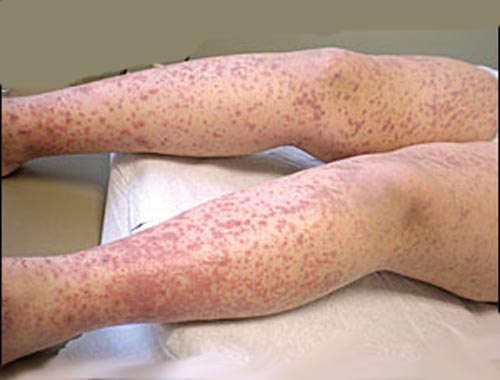Immune Thrombocytopenic Purpura (ITP,Idiopathic Thrombocytopenic Purpura)

Published: 18 Jun 2025
ICD9: 287.31 ICD10: D69.3 ICD11: 3B64.10
Immune Thrombocytopenic Purpura (ITP), also known as Idiopathic Thrombocytopenic Purpura, is a bleeding disorder in which the immune system destroys platelets.
Platelets are blood cells that help the blood clot. When you have fewer platelets than normal, you are at risk for bleeding and bruising.
Let's break down the terms:
![]() Immune: This means the body's immune system is involved. In ITP, the immune system mistakenly attacks the body's own platelets.
Immune: This means the body's immune system is involved. In ITP, the immune system mistakenly attacks the body's own platelets.
![]() Thrombocytopenic: This refers to a low platelet count (thrombocytopenia). "Thrombo" refers to platelets, "cyto" refers to cells, and "penia" means a deficiency.
Thrombocytopenic: This refers to a low platelet count (thrombocytopenia). "Thrombo" refers to platelets, "cyto" refers to cells, and "penia" means a deficiency.
![]() Purpura: This describes the purplish spots or bruises that can occur due to bleeding under the skin.
Purpura: This describes the purplish spots or bruises that can occur due to bleeding under the skin.
In simpler terms: ITP happens when your body's immune system mistakenly destroys its own platelets, leading to a lower-than-normal platelet count and an increased risk of bleeding and bruising.
Key aspects of ITP:
![]() Cause: The exact cause is often unknown (hence "idiopathic"). However, it's believed to be an autoimmune disorder where the immune system produces antibodies that attack platelets.
Cause: The exact cause is often unknown (hence "idiopathic"). However, it's believed to be an autoimmune disorder where the immune system produces antibodies that attack platelets.
![]() Symptoms:
Symptoms:![]()

![]() Easy bruising (purpura)
Easy bruising (purpura)![]()

![]() Tiny, flat, pinpoint-sized red or purple spots on the skin (petechiae)
Tiny, flat, pinpoint-sized red or purple spots on the skin (petechiae)![]()

![]() Bleeding from the gums or nose
Bleeding from the gums or nose![]()

![]() Heavy menstrual periods
Heavy menstrual periods![]()

![]() Blood in urine or stool
Blood in urine or stool![]()

![]() Prolonged bleeding from cuts
Prolonged bleeding from cuts![]()

![]() Fatigue
Fatigue
![]() Diagnosis: ITP is usually diagnosed through a blood test that shows a low platelet count and after ruling out other possible causes of thrombocytopenia.
Diagnosis: ITP is usually diagnosed through a blood test that shows a low platelet count and after ruling out other possible causes of thrombocytopenia.
![]() Treatment: Treatment depends on the severity of the condition. Some people with mild ITP may not need treatment, while others may require medications to boost platelet counts or suppress the immune system. Treatments can include:
Treatment: Treatment depends on the severity of the condition. Some people with mild ITP may not need treatment, while others may require medications to boost platelet counts or suppress the immune system. Treatments can include:![]()

![]() Corticosteroids (e.g., prednisone): To suppress the immune system.
Corticosteroids (e.g., prednisone): To suppress the immune system.![]()

![]() Intravenous Immunoglobulin (IVIG): Provides healthy antibodies to slow the destruction of platelets.
Intravenous Immunoglobulin (IVIG): Provides healthy antibodies to slow the destruction of platelets.![]()

![]() Rho(D) Immune Globulin: Another option to slow platelet destruction (used only in Rh-positive individuals).
Rho(D) Immune Globulin: Another option to slow platelet destruction (used only in Rh-positive individuals).![]()

![]() Thrombopoietin Receptor Agonists (e.g., romiplostim, eltrombopag): Stimulate the bone marrow to produce more platelets.
Thrombopoietin Receptor Agonists (e.g., romiplostim, eltrombopag): Stimulate the bone marrow to produce more platelets.![]()

![]() Splenectomy (surgical removal of the spleen): In some cases, if medications don't work. The spleen is where platelets are destroyed.
Splenectomy (surgical removal of the spleen): In some cases, if medications don't work. The spleen is where platelets are destroyed.
![]() Types:
Types:![]()

![]() Acute ITP: Usually seen in children and often follows a viral infection. It often resolves on its own within a few months.
Acute ITP: Usually seen in children and often follows a viral infection. It often resolves on its own within a few months.![]()

![]() Chronic ITP: Lasts longer than 6 months and is more common in adults.
Chronic ITP: Lasts longer than 6 months and is more common in adults.
![]() Who is affected? ITP can affect both children and adults, but it is more common in women than men.
Who is affected? ITP can affect both children and adults, but it is more common in women than men.
Important Considerations:
![]() Consult a Doctor: If you suspect you have ITP, it's crucial to see a doctor for proper diagnosis and treatment.
Consult a Doctor: If you suspect you have ITP, it's crucial to see a doctor for proper diagnosis and treatment.
![]() Bleeding Risks: People with ITP need to be careful to avoid injuries that could lead to bleeding.
Bleeding Risks: People with ITP need to be careful to avoid injuries that could lead to bleeding.
![]() Medication Management: It's important to follow your doctor's instructions carefully regarding medications and monitoring.
Medication Management: It's important to follow your doctor's instructions carefully regarding medications and monitoring.
This information is for general knowledge and does not substitute professional medical advice. Always consult with a qualified healthcare provider for any health concerns or before making any decisions related to your health or treatment.